Trinity's Stained Glass Windows & Their History
Years ago, monies were donated to Trinity Lutheran Church for Stained Glass restoration in memory of loved ones. We recently used these donated funds, to restore the large windows on both the west and east sides of the church. Here is a description of what those windows mean, taken from the original material provided by the company that installed them:
Chancel windows – Left lancet from top to bottom:

Here are the symbols of the Means of Grace, the Word of God and the two Sacraments. At the top is the chalice, symbolizing the Sacrament of the Altar. In the center is the open Bible, symbolizing the Word. At the bottom is the font, a symbol of the Sacrament of Holy Baptism.
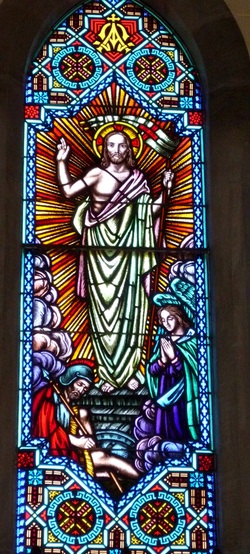
In the center window at the top is the Alpha and Omega combined with the cross. Alpha and Omega are the first and last letters in the Greek alphabet, and when combined with the cross stand for Jesus Christ, the first and last, the beginning and the end of all things. He is called Alpha and Omega in the Book of Revelation. Below is the figure of the risen and triumphant Savior and figures of an angel and Roman soldier associated in the account of the resurrection.
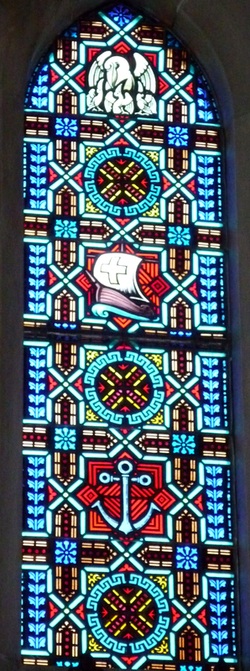
Right lancet window, starting at the top is the Pelican-in-her-Piety which is one of the most striking and widely used symbols of our Lord’s atonement. A pelican is shown plucking open her breast, feeding her young with her own blood. In times of famine, the female pelican is supposed to tear open her breast and feed her young with her own life blood. She dies in order that they may live. In like manner our blessed Savior shed His blood and died upon a cross that we may live. In the center is a ship with a cross-shaped mast, sailing through troubled waters. It symbolizes the Ship of the Church, tossed by storms of persecutions, heresy and schisms; threatened with destruction by indifference, rationalism and false teachers. But the presence of the Lord gives assurance of safety. Below is the anchor and cross which symbolizes the Christian’s hope. This hope is in Christ, the Anchor of the soul.
The Narthex windows – above the balcony:

Starting at the top of the left lancet window is the symbol of the winged man, representing the Evangelist St. Matthew. Symbols of the four Evangelists are four winged creatures mentioned in Ezekiel and Revelation, namely, the winged man, the winged lion, the winged ox and the eagle. The winged man symbolizes St. Matthew because the Evangelist begins his Gospel by tracing the human descent of our Savior. In the center is the symbol of the Father. The Manus Dei, the Hand of God, is shown as open and proceeding from a cloud of glory and surrounded by the three-rayed nimbus of light. The hand of God is based on Bible passages which speak of "His right hand" or simply "the hand of God." Below is the winged lion, symbol of the Evangelist St. Mark because he opens his inspired Gospel by describing John the Baptist who was the voice of one crying in the wilderness. At the bottom of the left lancet window is the Bible and Torch. The torch is the symbol of enlightenment. So the Word of God gives spiritual light.

In the center window of the Narthex, starting at the top, is the dove, symbol of the Holy Ghost. Below is the figure of Jesus, our Good Shepherd, with sheep and carrying a lamb in His arms. This is a very familiar figure of our Savior based upon the narrative in John 10. At the bottom is the Sun with the letters IHC. These letters stand for the first two and last letters of the Greek word meaning "Jesus." He is the Son of Righteousness.

On the right lancet window starting at the top is the winged ox, the symbol of the Evangelist St. Luke because he gives a very full account of the sacrificial death of our Savior. Below is the Agnus Dei, Lamb of God, lying upon the Book of Seven Seals and crowned with the three-rayed nimbus,
signifying that it is a symbol of divinity. The Lamb of God tells the story of man’s sin, and the Sacrifice of the Lamb of Calvary. This symbol is of most ancient origin, and is based upon such Bible passages as Isaiah 53:7, John 1:29, and Revelation 5:12. At the bottom is the Cross and Crown, which symbolize the life of the believer that leads through the Cross of Christ to the Crown of Eternal Life.
signifying that it is a symbol of divinity. The Lamb of God tells the story of man’s sin, and the Sacrifice of the Lamb of Calvary. This symbol is of most ancient origin, and is based upon such Bible passages as Isaiah 53:7, John 1:29, and Revelation 5:12. At the bottom is the Cross and Crown, which symbolize the life of the believer that leads through the Cross of Christ to the Crown of Eternal Life.
Medallions with symbols on the south side of Nave:
Starting from east to west or from the chancel to the narthex - Symbols of our Lord's Passion:
Window 1:
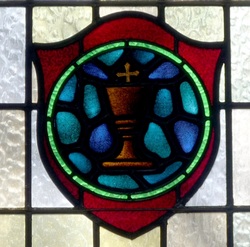
The chalice with a cross rising out of it symbolizes Gethsemane and the words of Jesus in His prayer of the cup of suffering.
Window 2:
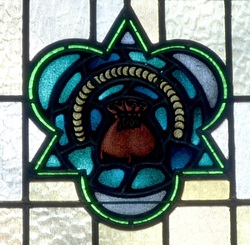
The betrayal of Judas - the bag and the 30 pieces of silver.
Window 3:
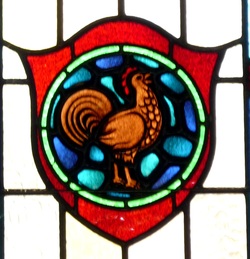
Peter's denial - the crowing cock.
Window 4:
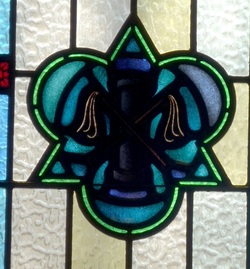
The pillar and scourges - symbolizing the scourging of our Savior.
Window 5:

The crown of thorns - placed upon the Savior's head.
Window 6:
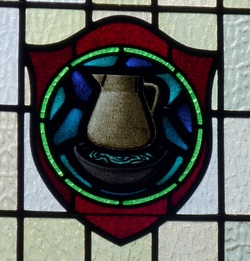
The ewer and basin - Pilate washing his hands.
Window 7:

Hammer and nails - used to crucify Jesus.
Window 8:
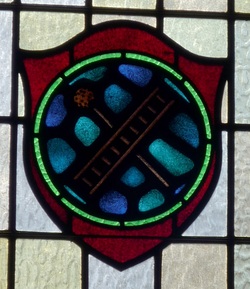
Ladder, reed and sponge - symbols of the crucifixion when Jesus cried "I thirst!"
Window 9:
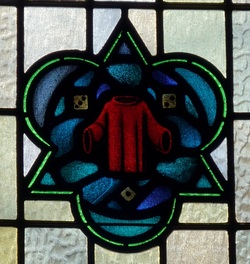
The seamless coat and dice - Roman soldiers beneath the cross cast lots for the Savior's seamless coat.
Window 10:

The heart pierced by a lance - a soldier pierced the heart of Jesus by thrusting his spear in Jesus' side to make sure He was dead.
Window 11:
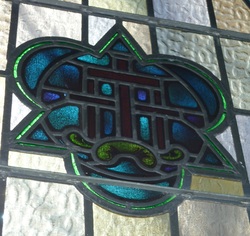
The three crosses on Calvary - the cross of Jesus in the center and those of the two malefactors crucified on either side of Him.
Medallions with symbols on the north side of Nave:
Starting from east to west or from the chancel to the narthex - Symbols of the Church Year.
Window 1:

The scroll - symbol of the Old Testament with the prophecies of the coming Messiah. The scroll symbolizes Advent.
Window 2:
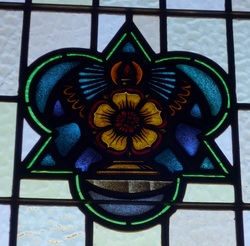
The rose and candle - symbolizes the Nativity of Jesus Christ.
Window 3:

The Passion Cross with Passion symbols. The lantern used by the enemies of Jesus to take Him captive in Gethsemane; the crown of thorns; the nails and the superscription on the cross, INRI, Jesus of Nazareth, the King of the Jews. These are symbols of Lent.
Window 4:

The cross and lillies - symbols of Easter.
Window 5:

The flaming chariot - the flaming chariot of Elijah is a favorite symbol of the Ascension of our Lord.
Window 6:
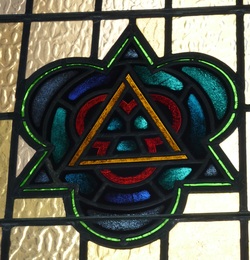
The trefoil and triangle - symbol of the Trinity. A decorative figure is formed when the equilaterial triangle and the trefoil are combined.